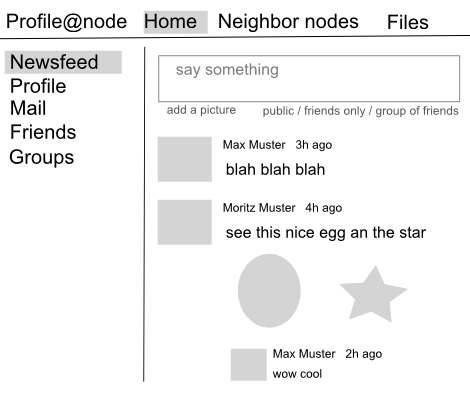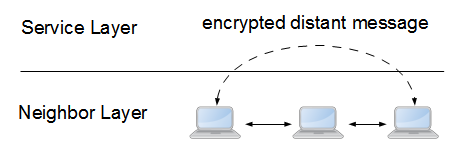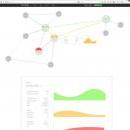Retroshare is a communication tool build on two principles: decentralisation and privacy (Read more about the ideals behind Retroshare). Decentralisation means there is no central server. It also leads to privacy, because Retroshare runs on your own devices. Retroshare gives you the cryptographic tools to control who exactly can access your data. Privacy is enabled by encrypting all data which goes over the wire. Read Cryptography and Security in Retroshare for details.

Figure 1: Retroshare is a decentralized network.
Commercial social networks like Facebook have opposite properties: they are centralized and all data is visible to one company. The good news is: similar features to Facebook are also possible in a decentralized manner. The plan is to build this as a plugin for Retroshare. Always having decentralisation and privacy in mind, while offering a very similar interface with a similar feature set.

Figure 2: Sketch of the user interface.
Unlike other peer-to-peer software, Retroshare connects only to a set of trusted friends. This has some practical advantages, for example you don’t have to fear malicious peers. It still scales nicely, because friends tend to gather the same type of data.
But often you want to reach content that was not created by your direct friends. Or you want to contact someone because you are not friends yet. For this Retroshare offers another layer which i call the service layer. At first a service can send messages to direct neighbors only. But if it receives a data packet it can also forward it to a friend. This is how you can reach friends of friends. This philosophy has been applied to multiple information sharing algorithms within Retroshare. Read more about them in the following articles on the Retroshare team blog: Retroshare Forums, Distributed chat(a.k.a. Chat Lobbies), RetroShare’s anonymous routing model and Distant chat and messaging, using generic tunnels.

Figure 3: Retroshare forwards messages from friend to friend
On the neighbor Layer, you have to add your friends keys to your keyring by hand. But this is not a problem in practice, because the number of direct friends is small and Retroshare offers various options to get to know neighbor nodes one hop away. On the service layer you want to have the public keys of people many hops away. In Retroshare v0.6 there is a identity exchange system, which downloads public keys at the same time it receives a post from a unknown author. The identity exchange system can also work decoupled from the neighbor layer. This allows us to have pseudonymous identities. These identities can be used for different kinds of services like chat, mail, forums and the new social network plugin.
Retroshare is a steadily grown project, so the developers gained a lot of experience. Out of this they developed new systems to distribute messages in a Retroshare network (short name is gxs for General Exchange System). So all the complex code for doing the signing, verification, encryption and decryption of data is already done and avaliable. During the Summer of Code i will wrap this complex stuff in a nice webbased user interface. The RSWebUI Plugin is a starting point. It uses Wt, which is a library to create a webinterface with C++, without writing own code in web languages. You can watch the development in the git repository.
Read the next blog post to learn what features the social network plugin will have and how it will work in details.
Download Retroshare: http://retroshare.org
About me: i study electrical engineering. I first started programming to control hardware. I came to Retroshare because i wanted to chat securely without depending on a server. Then i started to dream about what else would be possible with a secured connection. So i started reading the code. Today i have enaugh knowlegde to contribute.
